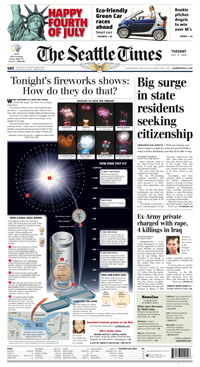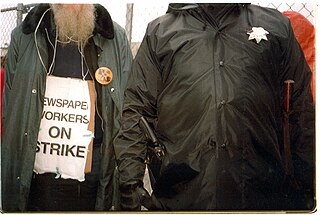
Hearst Communications, Inc., often referred to simply as Hearst, is an American multinational mass media and business information conglomerate based in Hearst Tower in Midtown Manhattan in New York City.

The International Brotherhood of Teamsters (IBT) is a labor union in the United States and Canada. Formed in 1903 by the merger of the Team Drivers International Union and the Teamsters National Union, the union now represents a diverse membership of blue and white-collar workers in both the public and private sectors, totalling about 1.3 million in 2015. The union was formerly called the International Brotherhood of Teamsters, Chauffeurs, Warehousemen and Helpers of America.

The Seattle Times is a daily newspaper serving Seattle, Washington, United States and its suburbs. Founded in 1891, it has been owned by the Blethen family since 1896. The Seattle Times has the largest circulation of any newspaper in the state of Washington and the Pacific Northwest region. The Seattle Times had a longstanding rivalry with the Seattle Post-Intelligencer until the latter ceased publication in 2009.

The Seattle Post-Intelligencer is an online newspaper and former print newspaper based in Seattle, Washington, United States.

William George Meany was an American labor union leader for 57 years. He was the key figure in the creation of the AFL–CIO and served as the AFL–CIO's first president, from 1955 to 1979.

The Minneapolis general strike of 1934 grew out of a strike by Teamsters against most of the trucking companies operating in Minneapolis, the major distribution center for the Upper Midwest. The strike began on May 16, 1934 in the Market District. The worst single day was Friday, July 20, called "Bloody Friday", when police shot at strikers in a downtown truck battle, killing two and injuring 67. Ensuing violence lasted periodically throughout the summer. The strike was formally ended on August 22.

The NewsGuild-CWA is a labor union founded by newspaper journalists in 1933. In addition to improving wages and working conditions, its constitution says its purpose is to fight for honesty in journalism and the news industry's business practices. The NewsGuild-CWA now represents workers in a wide range of roles including editorial, technology, advertising, and others at newspapers, online publications, magazines, news services, and in broadcast. The current president is Jon Schleuss.

The Pittsburgh Post-Gazette, also known simply as the PG, is the largest newspaper serving metropolitan Pittsburgh in the U.S. state of Pennsylvania. Descended from the Pittsburgh Gazette, established in 1786 as the first newspaper published west of the Allegheny Mountains, the paper formed under its present title in 1927 from the consolidation of the Pittsburgh Gazette Times and The Pittsburgh Post.

David Daniel Beck was an American labor leader, and president of the International Brotherhood of Teamsters from 1952 to 1957. He helped found the "Conference" system of organization in the Teamsters union, and shot to national prominence in 1957 by repeatedly invoking his right against self-incrimination before a United States Senate committee investigating labor racketeering.

Daniel Joseph Tobin was an American labor leader and president of the International Brotherhood of Teamsters from 1907 to 1952. From 1917 to 1928, he was treasurer of the American Federation of Labor. He served on the federation's Executive Council beginning in 1934, and served until his resignation in 1952.
The International Typographical Union (ITU) was a North American trade union for the printing trade for newspapers and other media. It was founded on May 3, 1852, in the United States as the National Typographical Union, and changed its name to the International Typographical Union at its Albany, New York, convention in 1869 after it began organizing members in Canada. The ITU was one of the first unions to admit female members, admitting women members such as Augusta Lewis, Mary Moore and Eva Howard in 1869.
Terry Pettus was a newspaper reporter and activist from Seattle, Washington.
A paper local is a local union with no or few members, chartered by an existing union or self-chartered, and formed for the purpose of criminal activity. As implied by the name, paper locals often "exist only on paper", and have no members. In some cases, however, paper locals may have members, but the members are not workers but rather friends, family members, or criminal associates of the individual or individuals in control of the paper local.
The Rochester Journal-American was an American newspaper in Rochester, New York owned by William Randolph Hearst.

The San Francisco newspaper strike of 1994 was a labor dispute called by the Newspaper Guild in November 1994. Employees of San Francisco's two major daily newspapers, the San Francisco Chronicle and The San Francisco Examiner walked off the job for eleven days.
The Martin Luther King, Jr. County Labor Council (MLKCLC) is the central body of labor organizations in King County, Washington. The MLKCLC is affiliated with the national AFL–CIO, the central labor organization in the United States, which represents more than 13 million working people. Over 125 organizations are affiliated with the MLKCLC, and more than 75,000 working men and women belong to Council-affiliated organizations. Not only does the MLKCLC support labor organizations, but it acts as a voice for the interests and needs of the working people in King County, WA.

The Detroit Newspaper Strike was a major labor dispute which began in Detroit, Michigan on July 13, 1995, and involved several actions including a local boycott, corporate campaign, and legal charges of unfair labor practices. The primary action involved around 2,500 members of six labor unions going on strike from July 13, 1995, to February 14, 1997. The unions ended their strike on February 14, 1997, and it was resolved in court three years later, with the journalists' union losing its unfair labor practices case on appeal.
The 2018 Atlanta sanitation strike was a labor strike involving 120 sanitation workers for Republic Services in Atlanta, Georgia, United States. The workers, members of the International Brotherhood of Teamsters, went on strike on August 10, 2018, with the strike ending later that day. Several days later, the union and company reached an agreement on new labor contracts.
The 2021 Hunts Point Produce Market strike was a labor strike involving workers for Hunts Point Produce Market in the Hunts Point neighborhood of the Bronx, New York City. The strike was carried out by about 1,400 members of Teamsters Local 202, all "produce handlers and delivery drivers" according to The Wall Street Journal. An agreement to end the strike was reached on January 23, 2021.












